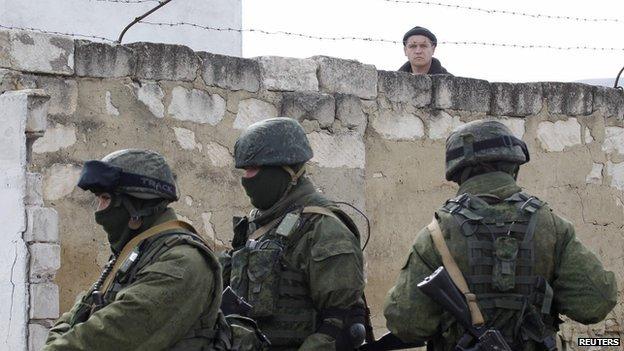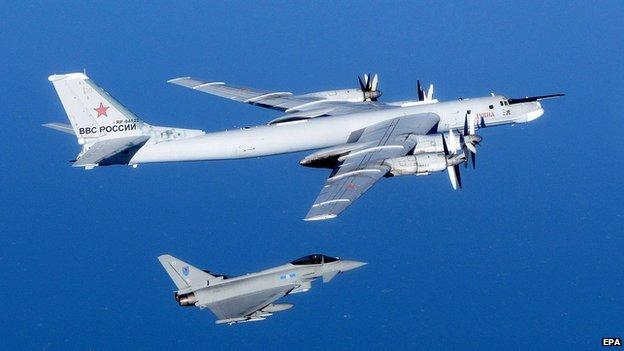Russia's 'close military encounters' with Europe documented
- Published

Russia's actions in Ukraine and Nato's response has led to an escalation of military tension across Europe
The growing strains between Russia and the West prompted by the Ukraine crisis are now sending ripples of military tension across Europe.
Nato has responded to Russia's incursions into Ukraine by stepping up its ties with Kiev and bolstering air patrols and exercises with its eastern and central European members.
Russia in turn has decided to pursue a more active, many might say a more aggressive, military policy of its own, returning to the sorts of flights and activities from the Cold War years that were used to regularly test out Nato defences.
The European Leadership Network, a London-based think tank, has produced a detailed study of this more assertive Russian activity.
Close encounters
Entitled Dangerous Brinkmanship: Close Military Encounters Between Russia and the West in 2014, external, it chronicles almost 40 specific incidents that have occurred during the past eight months.
It says these "add up to a highly disturbing picture of violations of national airspace, emergency scrambles, narrowly avoided mid-air collisions, close encounters at sea and other dangerous actions happening on a regular basis over a very wide geographical area".
Key incidents by date
-
× -
5 September: Abduction of an Estonian security service operative
×INCIDENT: Estonian security service operative captured by Russian agents on Estonian territory in a raid involving communications jamming and smoke grenades. Incident took place immediately after Obama’s assurances to the Baltic States.
CATEGORY: High Risk. Incursion into NATO member state’s territory. Had the Estonian official or his colleagues resisted, fatalities on either side would have been a catalyst for further escalation.
-
3 March: Near-collision between airliner and Russian aircraft
×INCIDENT: A commercial airline narrowly avoids collision with a Russian recon aircraft due to the latter’s not broadcasting its position.
CATEGORY: High Risk. Had a collision occurred, this would have caused a major diplomatic response, condemnation and further isolation of Russia.
-
June: Simulated attack by Russian aircraft on Denmark
×INCIDENT: Armed Russian aircraft approach the heavily populated Danish island of Bornholm before breaking off in what appears to have been a simulated attack.
CATEGORY: Serious. The Danish intelligence service described the incident as “of a more offensive character than observed in recent years.” At the time of the simulation, the island in question was hosting a major meeting of Danish politicians and journalists.
-
16 July: Provocative Russian action aimed at Swedish aircraft
×INCIDENT: Armed Russian aircraft intercepts Swedish surveillance plane conducting operations between Gotland and Latvia in international airspace, flies 10 metres from the plane.
CATEGORY: Serious. Indicated more aggressive approach by intercepting aircraft than in previous encounters.
-
18 July: US aircraft violates Swedish airspace to avoid Russian interceptor
×INCIDENT: American surveillance plane conducting operations near Kaliningrad takes refuge in Swedish air-space after being approached by Russian fighters. This evasive action takes place without prior Swedish approval.
CATEGORY: Serious. Indicated more aggressive approach by intercepting aircraft than in previous encounters and forced the U.S. aircraft to violate Swedish airspace.
-
August 2014: Multiple breaches of Finnish air-space by Russian state aircraft
×INCIDENT: Multiple breaches of Finnish air-space by Russian state aircraft.
CATEGORY: Serious. Finland has already articulated that it will respond more firmly to future violations, this is already an escalation.
-
17 September: Violation of Swedish airspace
×INCIDENT: Two Russian military aircraft cross into Swedish air-space south of the island of Oland.
CATEGORY: Serious. Su-24 bombers intentionally violated Swedish airspace. Swedish Foreign Minister described it as 'most serious aerial incursion' in years.
-
17 - 27 October: Swedish 'underwater activity' hunt
×INCIDENT: Major submarine hunt prompted by reports of “underwater activity” in Swedish territorial waters.
CATEGORY: High Risk. Biggest anti-submarine operation in Sweden since the Cold War.
-
28 - 30 October: Massive surge of Russian aviation activity along NATO borders
×INCIDENT: In a series of developments, aircraft from Nato states and partners track Russian long-range bombers conducting missions over the North Sea, Atlantic and the Black Sea, as well as a big formation of Russian fighter and bombers conducting missions over the Baltic Sea; all missions conducted in international airspace
CATEGORY: Serious. Large-scale Russian air operation involving different kind of aircraft and different zones of operation. While no incursion into any national airspace was reported, the operation added to increased tensions along the Nato-Russia borders.

Apart from routine or near routine encounters, the report identifies "11 serious incidents of a more aggressive or unusually provocative nature, bringing a higher level risk of escalation".
These include harassment of reconnaissance planes, close over-flights over warships and Russian "mock bombing raid" missions.
It also singles out "three high-risk incidents which," in its view, "carried a high probability of causing casualties or a direct military confrontation".
The fact that one of these was a narrowly avoided collision between an SAS civil airliner taking off from Copenhagen and a Russian reconnaissance plane shows that these are not just military games.

Russian military flights into Europe have increased over the past year
There is a very real risk of calamity.
The Russian military aircraft was not using a transponder to identify its position.
Losing control
The second high-risk incident involved the abduction of an Estonian security service operative from a border post on Estonian (and hence Nato) territory.
He was later taken to Moscow and accused of espionage.
Then of course there was the major submarine hunt by the Swedish authorities last month, with the Swedes warning that they were ready to use force to bring any submerged vessel to the surface.
Sweden says there have been three sightings of a submarine near Stockholm since Thursday
The danger, the report indicates, comes from both sides.
"The mix of more aggressive Russian posturing and the readiness of Western forces to show resolve, increases the risk of unintended escalation and the danger of losing control over events."
Unresolved tension
The European Leadership Network makes three broad recommendations.
It says that "the Russian leadership should urgently re-evaluate the costs and risks of continuing its more assertive military posture, and western diplomacy should be aimed at persuading Russia to move in this direction".
It says that "all sides should exercise military and political restraint".
And it says that "all sides must improve military-to-military communication and transparency".
There is probably much that is sensible here.
But given the unresolved tensions over Ukraine, the overall trajectory of current Russian foreign policy and the pressures coming from those in Nato who feel most threatened, like the Poles, this pattern of behaviour risks becoming the new norm.

Nato has been scaling up its military drills in eastern and central Europe
Indeed the growing frequency and scale of Nato military exercises in eastern and central Europe is only likely to encourage the Russians to bolster their own military manoeuvres.
Procedures and operational patterns from the Cold War may need to be re-learnt.
We are not back in the 1950s.
But in some ways the dangers of bravado leading to miscalculation or of genuine error make matters today every bit as dangerous.